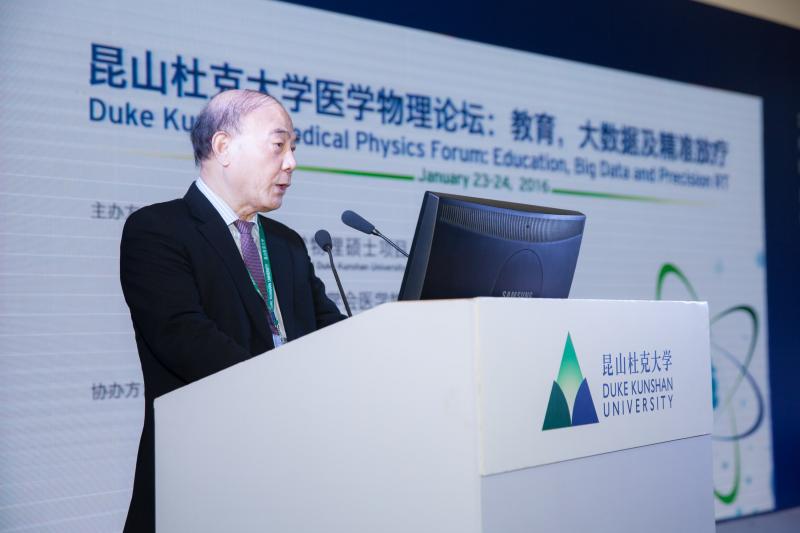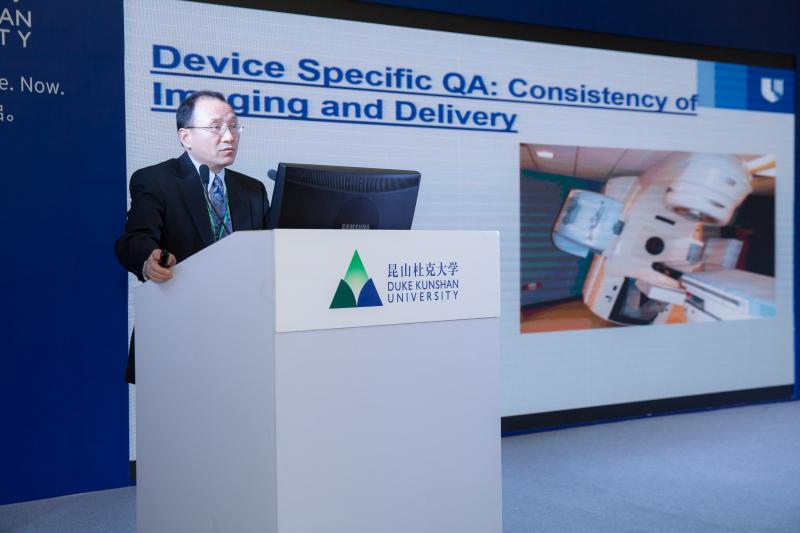January 23 and 24, over 160 scholars, government officials, and medical physics experts from China and overseas gathered with Duke Kunshan faculty and students at Duke Kunshan University’s first Medical Physics Forum: Education, Big Data and Precision RT. Held in conjunction with Jiangsu Biomedical Engineering Association – Medical Physics Branch, the forum focused on medical physics education in precision radiation therapy and SBRT clinical applications as well as molecular and anatomical imaging for accurate cancer therapy in the era of big data.
Medical physics plays critical roles in radiation therapy of cancers. The latest evolution of precision radiation oncology continuously stimulates innovations in biological, technological and clinical advances to provide personalized and evidence-based management of cancers. More and more information (both data and images) are generated toward this direction, which in turn leads to rapid development of big data application and analytics. As such, education in this field has become increasingly imminent. At this forum, leading radiation oncologists, physicists, technologists, researchers and students gathered to discuss the advances in imaging, technology and education of precision RT through roundtable discussion, expert panel forum and scientific presentation.

The event kicked off with a welcome speech from Liu Jingnan, chancellor of Duke Kunshan University and Academician of Chinese Academy of Engineering. As Liu pointed out, cancer has become a major health challenge that needs to be urgently tackled and an important subject in medical science. Precision radiation therapy requires extensive collaboration between doctors and medical physicists, which calls for more interdisciplinary efforts between medical science and physics. The medical physics graduate program at Duke Kunshan University has been brought into being to meet this rising demand.

Duke Kunshan Chancellor Liu Jingnan Delivering Welcome Speech
On behalf of Duke Kunshan University, Chancellor Liu awarded plaques to representatives from Suzhou Municipal Hospital??? Fudan University’s Affiliated Huadong Hospital, and Jiangsu University’s Affiliated Hospital for becoming medical physics training bases of Duke Kunshan University. ‘We are grateful for the support from the three partner hospitals.’ said Yin Fang-Fang, the forum chair, director of the Medical Physics Graduate Program at Duke Kunshan and professor in radiation oncology at Duke University. ‘This will greatly help us cultivate top medical physicists by allowing students to combine learning with doing.’

Chancellor Liu Awarding Plaques to Training Bases

Yin Fang-Fang, director of the Medical Physics Graduate Program at Duke Kunshan and professor in radiation oncology at Duke
He Xiang, deputy director of the Inspection and Supervision Bureau, National Health and Family Planning Commission, said in his congratulatory speech: ‘We have learned from the history that staffing radiation therapy hospitals with well-trained medical physicists is important for ensuring radiation therapy safety. I hope that Duke Kunshan University will continue to promote the cooperation between China and the US in the field of medical science and talent development.’
Focusing on the Future of Precision RT
As a distinguished feature of this forum, the 1st Duke Kunshan University Medical Physics Education Round Table Forum shed light on the technical and educational demands for precision radiation therapy and medical physics. The two round table discussion sessions were co-chaired by leading experts in radiation oncology, and explored the future direction in precision radiation therapy, and the expectation and education for medical physicists.
Commenting on the future of precision radiation therapy, Lang Jinyi, director of Sichuan Cancer Hospital and chair of China Society of Radiatio, said, ‘Better precision RT outcome is our shared goal, and big data can provide the information to achieve it. The big data is meaningless without effective application.’

First Round Table Discussion
‘The medical physics industry needs top talent, and medical physics is not limited to one single discipline. Therefore, education of medical physics should be interdisciplinary, and hospitals and universities should join forces to train the students,’ said Deng Xiaowu, associate director of department of radiation oncology, Sun Yat-sen University Cancer Center, and member of China Society of Radiation Oncology.

Second Round Table Discussion
Dialogue Between Industrial Leaders and Students
Following the Round Table Forum was a dialogue between industrial leaders and students, in which experts from prestigious hospitals and pharmaceutical companies introduced to Duke Kunshan MP students their recruitment plans.
‘The reality is that there are 560,000 patients per day who need radiation therapy in China, but there are only around 2500 qualified medical physicists. We are in dire needs of graduates trained in medical physics,’ said Susan Xia, marketing director of Varian Medical Systems, Greater China Area.
Standardization and Quality Assurance for Precision RT
During the conference symposium of the forum, more than 50 researchers from over 30 universities, hospitals and governmental agencies delivered 26 keynote speeches, and shared with audience the most cutting-edge research findings in SBRT technologies, clinical applications, and the role of modern molecular imaging on precision radiation therapy in the era of big data.
Several scholars affiliated with Duke University and Duke Kunshan University, including Christopher Willett, professor and chair of the Department of Radiation Oncology at Duke University, James Dobbins, professor of radiology at Duke University, James Bowsher, associate professor at Duke Kunshan University, Yin Fang-Fang and Wu Qingrong, professors at Duke University and Duke Kunshan University, and He Xia, co-chair of the program organization committee, professor and chair of the Department of Radiation Oncology at Jiangsu Province Cancer Hospital, presented their latest findings in Standardization for Precision RT, Radiomics, and SBRT Techniques. Furthermore, He Xiang, deputy director of Bureau of Inspection and Supervision, gave a detailed introduction to the laws and regulations for application of image-guided radiation therapy equipment in China.
It is also noteworthy that 5 graduate students from the Medical Physics program at Duke Kunshan University also presented their research projects that span multiple subjects, from precision RT, to RT quality assurance and planning.
‘It’s a great opportunity to be able to communicate with and learn from the chief physicists, physicians, from China and abroad, as well as the key Chinese government officials,’ said Zhu Wei, graduate student ’16. ‘Through this meeting, I have a deeper understanding of the development status of the Medical Physics Community in China and a clearer future career plan in this promising area.’

Zhu Wei, Duke Kunshan Graduate Student ’16

